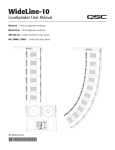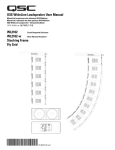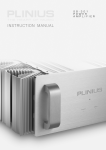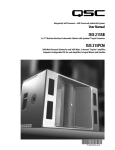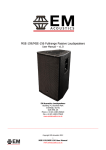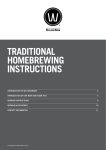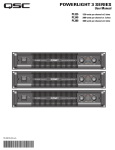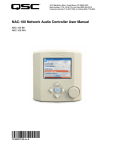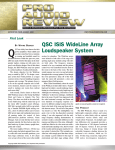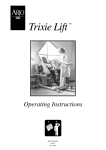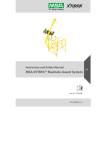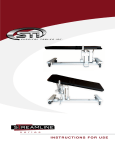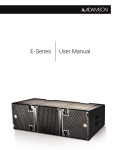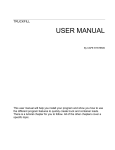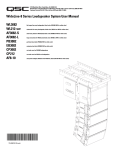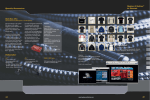Download QSC Speaker WL 2102 User's Manual
Transcript
ISIS WideLine Loudspeaker User Manual Model WL 2102 *TD-000188-00* TD-000188-00 rev.A IMPORTANT SAFETY PRECAUTIONS Install in accordance with QSC Audio Product's instructions and under the supervision of a licensed Professional Engineer. WARNING! Before placing, installing, rigging, or suspending any speaker product, inspect all hardware, suspension, cabinets, transducers, brackets and associated equipment for damage. Any missing, corroded, deformed, or non-load rated component could significantly reduce the strength of the installation, placement or array. Any such condition severely reduces the safety of the installation and should be immediately corrected. Use only hardware which is rated for the loading conditions of the installation and any possible short-term, unexpected overloading. Never exceed the rating of the hardware or equipment. Consult a licensed, Professional Engineer regarding physical equipment installation. Ensure that all local, state and national regulations regarding the safety and operation of flying equipment are understood and adhered to. Warranty (USA only; other countries, see your dealer or distributor) Disclaimer QSC Audio Products, Inc. is not liable for any damage to amplifiers or any other equipment that is caused by negligence or improper installation and/or use of this loudspeaker product. QSC Audio Products 3 Year Limited Warranty QSC Audio Products, Inc. (“QSC”) guarantees its products to be free from defective material and / or workmanship for a period of three (3) years from date of sale, and will replace defective parts and repair malfunctioning products under this warranty when the defect occurs under normal installation and use - provided the unit is returned to our factory or one of our authorized service stations via prepaid transportation with a copy of proof of purchase (i.e., sales receipt). This warranty provides that the examination of the return product must indicate, in our judgment, a manufacturing defect. This warranty does not extend to any product which has been subjected to misuse, neglect, accident, improper installation, or where the date code has been removed or defaced. QSC shall not be liable for incidental and/ or consequential damages. This warranty gives you specific legal rights. This limited warranty is freely transferable during the term of the warranty period. Customer may have additional rights, which vary from state to state. In the event that this product was manufactured for export and sale outside of the United States or its territories, then this limited warranty shall not apply. Removal of the serial number on this product, or purchase of this product from an unauthorized dealer, will void this limited warranty. Periodically, this warranty is updated. To obtain the most recent version of QSC’s warranty statement, please visit www.qscaudio.com. Contact us at 800-854-4079 or visit our website at www.qscaudio.com. © Copyright 2005, QSC Audio Products, Inc. QSC® is a registered trademark of QSC Audio Products, Inc. Speakon® is a registered trademark of Neutrik® and the names of Neutrik® products referenced herein are either trademarks and/or service marks of Neutrik®. M1® is a registered trademark of Starrett® (The L.S. Starrett Company) LPS® is a registered trademark of LPS Laboratories All trademarks are the property of their respective owners. “QSC” and the QSC logo are registered with the U.S. Patent and Trademark Office 2 Introduction The WideLine loudspeaker system has been designed to provide a compact system that has similar power handling, frequency response, and coverage of larger systems. Its primary uses include ballrooms, theatres, night clubs, houses of worship, and small to medium size events for the corporate/industrial market. The WideLine system is suitable for stand alone applications as a full range, articulate, high fidelity, sound reinforcement product with the ability to reproduce almost any musical program without subwoofers or bass modules. It has bass response to 52 Hertz (-3 dB) in a small format package. Its 3way, biamp or triamp design keeps required amplification to a minimum. WideLine’s exceptionally wide dispersion practically eliminates the need for “side” or “fill” hangs when used as the main array. Its wide dispersion also provides enhanced coverage when used as a center cluster or as a downfill or underhang enclosure when used with larger format line array systems. Wide dispersion is accomplished with a 3” (76mm) diaphragm, 1.4” (36mm) exit neodymium high-frequency driver mounted on a proprietary, patent-pending multiple aperture diffractionslot waveguide. This device is the ideal linear source needed for line array performance. Internal, mid-frequency shading can be switched to either 10” (254mm) transducer. Both transducers handle the low-frequencies, but only the non-shaded transducer handles the mids. This provides smoother pattern control at the mid-high crossover. With selectable shading, the enclosures can be used as house right or left by flipping the switch, not the enclosure. The enclosure is constructed of lightweight cored-composite and weighs only 70lbs. (31.8kg), including the self-contained rigging hardware. The hardware allows for simple vertical splay angle adjustment of 0, 2, 3, 4, 5, 6, 7, 8, 9, and 10° between enclosures. Two array grids are available. The small array frame supports up to 8 enclosures flown or 4 enclosures stacked. The large array frame supports up to 24 enclosures flown or 12 enclosures stacked. WideLine users can also use a software tool called EASE Focus to aid in the design and implementation of a WideLine array. EASE Focus can calculate the number of enclosures required for a given space (venue), determine the optimum splay angle between those enclosures, calculate at what angle to set the array grid in a single (variable) pick-point or fixed suspension point application, and predict the acoustical response and sound pressure levels throughout the venue in a two-dimensional illustration. The software is available separately; downloadable from the QSC website or contact QSC for more information. Like all ISIS products, WideLine design focuses on accurate audio performance, rapid set-up, and reduced labor requirments. Ease of transportation, assembly, use, and self-contained rigging hardware make WideLine the clear choice. Combined with the ISIS 82H, 102M, 102W, 122M, 152M, 215PCM, and 215SB, the WideLine array system provides the most comprehensive toolbox for any sound reinforcement professional. FRONT (grille removed) 1- Receiver tube (front left and right) with captive articulated joint (inside receiver tube) and ball-lock pins 2- Low frequency transducer B 3- High frequency transducer aperture 4- Low frequency transducer A REAR 5- Input / output connectors (NL8) 6- Rear link, mounting block, and ball-lock pin 7- Three way / two way selector switch 8- Low frequency (shading) selector switch 3 Three way Active/Two way Active Switch Two way active: The “full range” LF input is applied to pins 1+ and 1- and the -6dB per octave shading network is applied to one of the LF transducers using the Low Frequency Select switch (above). Three way active: Shading network is NOT applied (shading must be provided by upstream signal processing). Connect the full-range input signal to pins 1+ and 1-, connect the shaded (processed) signal to pins 2+ and 2-. To flip shaded transducer location, use the Low Frequency Select switch or alter signal processing. Default Low Frequency Select switch position for three way mode is position A; if put in position B, connections (per Table 1) to LF transducers A and B are interchanged. Low Frequency Select Switch The WideLine is a three way design (shaded, non-shaded and high frequency) with shading provided by a passive network in two way mode or upstream signal processing (DSP) in three way mode. This allows switch position selection for use as either “house left” or “house right”, without the need to flip boxes. Two way Mode: The shading switch allows either low frequency transducer to be selected as the shaded unit (bass only) by inserting a -6dB per octave network. The switch handle points to the side of the non-shaded (full range) low-frequency transducer. Three way Mode: The internal -6dB per octave network in NOT applied to either LF transducer. Shading is accomplished with signal processing. The switch handle points to the side of the non-shaded (full range) low-frequency transducer ONLY IF the full range signal is applied to pins 1+ and 1- and the shaded signal to pins 2+ and 2-. Default position for three way mode is position A; if put in position B, connections to LF transducers A and B are interchanged. 4 Input Connections The input connectors are a pair of Neutrik NL8's wired in parallel. Connections for biamp and triamp vary, see Table 1. The pin designations for the NL8FC cable connector is shown for reference, bottom right. Note! In three way mode, the Low Frequency Select switch position determines the input connector wiring! Unexpected results may occur if switch positions and wiring are not strictly controlled. The WideLine loudspeaker is not equipped with a crossover network. All signal processing must be done before connecting audio power to the loudspeaker. Do not connect full-range audio to the high-frequency transducer or damage may result! Table 1: Input Connector Wiring, Two way and Three Way Modes Two Way Internal Shading Network Inserted in Signal Path Three Way Use External Processing for Shading, LF Select Switch Position A Three Way Use External Processing for Shading, LF Select Switch Position B 1+ LF + LF A + LF B + 1- LF - LF A - LF B - 2+ Not Used LF B + LF A + 2- Not Used LF B - LF A - 3+ Not used Not used Not used 3- Not used Not used Not used 4+ HF + HF + HF + 4- HF- HF- HF - Pin Neutrik NL8FC Cable Connector Pinout Below is a diagram showing the pin designation inside the Neutrik NL8FC connector. This information is for reference only. Diagram is of the connector as viewed from the wire-insertion end. NL8FC pin designations- Plug viewed from the wiring side. 5 Rigging CAUTION: SUSPENDING SPEAKERS PRESENTS A RISK OF SERIOUS INJURY OR DEATH. PLEASE USE CAUTION TO ASSURE THAT MOUNTING SURFACES ARE CAPABLE OF SUPPORTING AT LEAST FIVE TIMES THE WEIGHT OF THE SPEAKER AND MOUNTING APPARATUS. USE ONLY LOAD RATED HARDWARE. ALWAYS CONSULT WITH A CERTIFIED PROFESSIONAL WHEN IMPLEMENTING OVERHEAD SUSPENSION. The large array frame’s maximum array is twenty-four (24) enclosures. Weight of a twenty-four box system is only 1680lbs and the large array frame weighs 83lbs. The small array frame supports a maximum of eight (8) enclosures with a system weight of 420lbs. and frame weight of 33lbs. The rigging hardware does not allow array assembly with any enclosure inverted. Front Articulated Joint- Slide the joint out of the receiver tube by sliding the retaining screw upward, then lock in place using the ball-lock pin. The rigging system for WideLine has been engineered to achieve a minimum of the industry standard strength ratio of 5:1 with 24 enclosures on the large array frame or 8 enclosures on the small array frame. Palos Verdes Engineering has certified the mechanical calculations, and destructive tests have been performed by ATM Flyware. WideLine enclosures use a three-point suspension system. The system consists of front, left/right, captive articulated joints and a single rear link blade. Articulation is in 2° increments using the first location on the link bar. With the use of the second location, 1° degree increments can be obtained starting at 3°. The total available angular increments are: 0, 2, 3, 4, 5, 6, 7, 8, 9, and 10°. All pieces and locking pins remain with the enclosures. No ancillary items are needed to fly the enclosures from the WideLine grid. All ball-lock pins are equipped with a lanyard to help prevent loss. Front Articulated Joint (Knuckle) Hardware Expose the end of the articulated joint by locating the joint’s retaining screw protruding from the front of the receiver tube and sliding it upward. The front captive joint will slide upward from the enclosure’s receiver tube. The exposed end of the articulated joint can now be inserted into the adjacent enclosure’s receiver tube and locked into position by a locking pin. This is repeated for each side of the enclosure. Then the rear link blade can be rotated into position and pinned at the chosen degree increment. Rear Link (Angle Adjust) Hardware The rear link is stored with the link folded between the sides of the block. To expose the link, remove the ball-lock pin and rotate the link into the desired position. Once positioned, the link is secured using the ball-lock pin of the adjacent enclosure. The rear link is marked with a thin, white line at the “normal” (0°) position and with a “+3” at the +3° position. The additional ball-lock pin hole (located approximately midway on the link) is used for storing the link when folded into the enclosure’s block for storage. The link may be pinned in place at the 0° or 8° location on the block when rotated into the storage position. 6 Rear Link-Remove the ball lock pin from the storage position, then rotate the link downward to the adjacent enclosure. Lock in place using the ball-lock pin. Adjusting the Angle Between Enclosures (Splay) The illustration shows the rear pin block of two enclosures joined by the upper enclosure’s rear link arm. Use the first pin location (closest to the end) on the link arm for setting in normalized 2° increments. The leftside example shows two enclosures linked for 8° of splay. The ball-lock pin is inserted into the 8° position in the rear block while passing through the “normal” pin hole in the link. When the "+3" location is used, an additional 3° are added to the "normalized" location. The right side example shows two enclosures linked for 9° of splay. The ball-lock pin is inserted into the 6° position in the rear block while passing through the “+3°” pin hole in the link. The total splay is the 6° indicated on the block, plus the 3° additional from the link position, for a total of 9°. In this manner 1° increments can be attained starting with 3° (0° block location and +3° link arm location). Rear link attached to achieve an 8° splay between enclosures. Rear link attached to achieve a 9° splay between enclosures. Array Frames (Fly Grids) There are two array frames available for the WideLine system. The large frame is used for flying a typical four to twenty-four-box array. The large grid may be inverted and used to stack up to twelve or more enclosures. A compact and easier to handle frame is available for use as a small array, four or less, stacking or fly grid. This grid will easily sit on deck stacked bass enclosures or it can be used at those smaller events to fly clusters from the stage trusses. Large Array Frame (Fly Grid) Do not fly (suspend) more than twenty-four (24) enclosures form the large array frame. Do not stack more than twelve (12) enclosures on a large array frame. Use only 5/16” diameter x 1.25” long balllock pins on front receiver tubes. The three pick up rails allow for any number of rigging solutions to fit the most demanding venues. The rails are drilled for industry standard 5/8" shackles. 7 Large Array Frame (continued) The mounting plate and link on are located on the bottom side of the frame assembly. Use this link for attaching the rear of the first enclosure. The grid allows for up or down angle options for use with either stacking or flying. The 4° “normal” locations on the link system will yield a net 0° vertical inclination. Use 4° link location for 0° vertical inclination Small Array Frame (Stacking Grid) Do not fly (suspend) more than eight (8) enclosures form the small array frame. Do not stack more than four (4) enclosures on a small array frame. Use only 5/16” diameter x 1.25” long ball-lock pins on front receiver tubes. The small frame will easily handle four enclosures and will interface with the QSC 215PCM or 215SB subwoofer in both a stacked or flown configuration. The stacking bumpers on the frame may need to be moved to the opposite side of the frame member for use. The small frame is constructed using standard “L” track for rigging. 8 Stacking the Small Array Frame The small array frame comes with two aluminum I-bars used for aligning and securing the frame to QSC’s “215” subwoofer. To use the I-bars, simply slide each one into the small frame’s L-track and secure with a stud fitting. Then, turn the frame over (I-bars on the bottom) and slide the exposed I-bars into the subwoofer’s L-track. Secure the I-bar with a stud fitting. Note that the stud fittings used are not required to be load rated as they only retain the I-bars from moving laterally. When stacking a small array frame on top of QSC’s 215SB or PCM cabinet, use the I-beam inserts (1 in each L-track) to assure proper alignment and to firmly secure the frame to the 215 cabinet. Secure using stud fittings. Do not stack more than four (4) enclosures on a small array frame. Care The socket head cap screws used on the WideLine products are load-rated high-strength steel, not stainless steel. Stainless screws are not rated to handle the necessary load. Should any hardware require replacement, contact QSC’s Technical Services for spare parts. The rigging hardware is stainless steel which has been black oxide coated. The oxide coating is not corrosion-free. We suggest wiping down all screws, pins, hardware, and frames with LPS ® Dry Film Lube or Starrett M1® All Purpose Lube before and after outside gigs to help prevent oxidation. This will not only prevent the formation of rust and other oxides, but also provide lubrication, adding to the longevity and ease-of-use of the WideLine product. 9 Preliminary System Specifications (subject to change without notice) Configuration: Three way, biamp (active two way) or triamp (full three way active) Frequency Response: 52Hz - 18KHz (+/- 3dB) Sensitivity: biamp: 97dB (2.83v @ 1m) triamp: 99dB (2.83v @ 1m) Nominal coverage: Horizontal:140deg. Nominal Impedance: 8 ohms, low frequency in biamp mode, 16 ohms low frequency in triamp mode 16 ohms, high frequency Transducers: Low Frequency: High Frequency: Recommended Amplifier Power: Vertical: Dependant on number of elements used two 10" (254mm) long excursion, high power, 3" (76mm) voice coil, 16 ohm, 380 watts rms each 3.0” (76mm) diaphragm, 1.4" (36mm) exit, 16 ohm neodymium compression driver on proprietary patent-pending waveguide, 80 watts rms 300 watts high frequency 700 watts mid frequency triamp mode 700 watts low frequency triamp mode 1400 watts low/mid frequency in biamp mode Enclosure: Type: Bass reflex (ported), trapezoidal Material: Cored Composite laminate Finish: Black or white texture coat Grille: Powder-coated steel Connectors: two Neutrik NL8 Attachment points: Self contained rigging configuration. Each front receiver tubes contains a captive articulated joint (knuckle) and two ball-lock pins on lanyards. Rear mounting block has integral mounting link and one ball-lock pin on lanyard. Weight: 70lbs, 31.8kg Dimensions: 10.75" H x 27.5"W x 20.25"D 27.3cm H x 69.85cm W x 51.43cm D Accessories Array Frames: Small array frame- 8 enclosure maximum for flown (suspended) applications, 4 enclosure max. for stacking on I-215 sub cabinet (deck applications). Frame weight 33lbs. / 15.0kg Large Array Frame- 24 enclosure maximum for flown (suspended) applications, 12 enclosure max. for deck stacking. Frame weight 84lbs. / 38.1kg 10 Software EASE Focus line array modeling software tool available; visit www.qscaudio.com or contact QSC’s Technical Services for DSP files for both QSControl.net and Signal Manager Ball-lock Pins 5/16” dia. x 0.75” long, t-handle: p-n SR000052-00 5/16” dia. x 1.25” long, button-handle: p-n SR000081-00 Dimensions 11 How to Contact QSC Audio Products Mailing address: QSC Audio Products, Inc. 1675 MacArthur Boulevard Costa Mesa, CA 92626-1468 USA Telephone Numbers: Main Number (714) 754-6175 Sales & Marketing (714) 957-7100 or toll free (USA only) (800) 854-4079 Customer Service (714) 957-7150 or toll free (USA only) (800) 772-2834 Facsimile Numbers: Sales & Marketing FAX (714) 754-6174 Customer Service FAX (714) 754-6173 World Wide Web: www.qscaudio.com E-mail: [email protected] [email protected] Warranty Disclaimer (USA only; other countries, see your dealer or distributor) QSC Audio Products, Inc. is not liable for any damage to amplifiers, loudspeakers, or any other equipment that is caused by negligence or improper installation and/or use of this signal processing product. While QSC has endeavored to develop and produce the most dependable and robust 'network' audio product for your use, due to the myriad of network situations and equipment that may be encountered in its implementation, QSC cannot be held responsible for network conflicts and associated consequences that may result. For this reason, QSC strongly recommends that the network used for implementation of QSControl products be completely separate from all other networks, data or otherwise. As such, should you elect to integrate QSControl products with your existing network system, all risks attendant to such integration of QSControl products with your existing network or network systems are assumed by you. While QSC strives to provide the highest quality technical solutions for networked audio products, in no event will QSC or its suppliers be held liable for any damages, consequential, incidental or otherwise, including any claims for lost profits and/or savings resulting from any attempted integration of QSControl products with your networking systems. No agent, employee or representative of QSC has any authority to alter or modify in any manner, the disclosures and recommendations set forth herein. QSC Audio Products 3 Year Limited Warranty QSC Audio Products, Inc. ("QSC") guarantees its products to be free from defective material and / or workmanship for a period of three (3) years from date of sale, and will replace defective parts and repair malfunctioning products under this warranty when the defect occurs under normal installation and use - provided the unit is returned to our factory or one of our authorized service stations via prepaid transportation with a copy of proof of purchase (i.e., sales receipt). This warranty provides that the examination of the return product must indicate, in our judgment, a manufacturing defect. This warranty does not extend to any product which has been subjected to misuse, neglect, accident, improper installation, or where the date code has been removed or defaced. QSC shall not be liable for incidental and/or consequential damages. This warranty gives you specific legal rights. This limited warranty is freely transferable during the term of the warranty period. Customer may have additional rights, which vary from state to state. In the event that this product was manufactured for export and sale outside of the United States or its territories, then this limited warranty shall not apply. Removal of the serial number on this product, or purchase of this product from an unauthorized dealer, will void this limited warranty. Periodically, this warranty is updated. To obtain the most recent version of QSC's warranty statement, please visit www.qscaudio.com. Contact us at 800-854-4079 or visit our website at www.qscaudio.com. QSC Audio Products, Inc. 1675 MacArthur Boulevard Costa Mesa, California 92626 USA ©2005 “QSC” and the QSC logo are registered with the U.S. Patent and Trademark Office.












